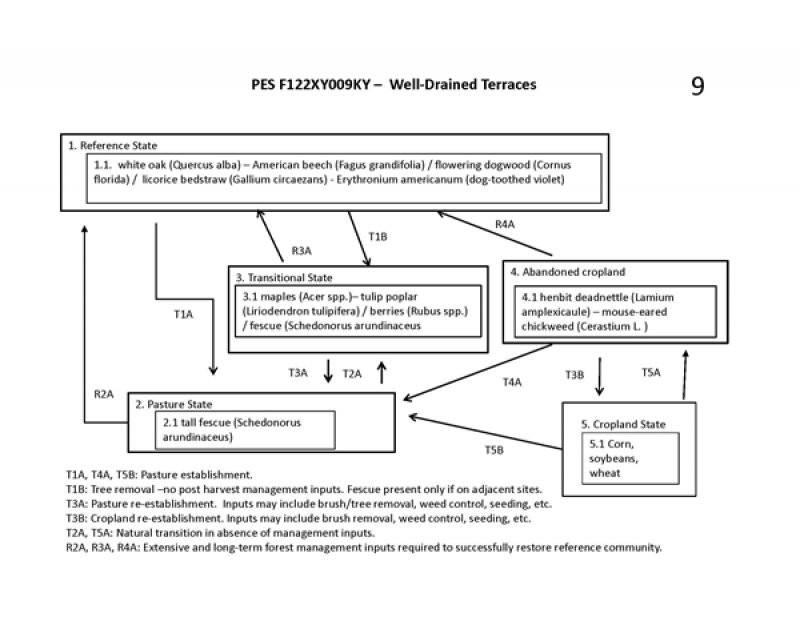
Natural Resources
Conservation Service
Ecological site F122XY009KY
Well Drained Terraces
Last updated: 5/14/2025
Accessed: 12/22/2025
General information
Provisional. A provisional ecological site description has undergone quality control and quality assurance review. It contains a working state and transition model and enough information to identify the ecological site.
MLRA notes
Major Land Resource Area (MLRA): 122X–Highland Rim and Pennyroyal
MLRA 122 is in Tennessee (47 percent), Kentucky (43 percent), Indiana (7 percent), and Alabama (3 percent). It makes up about 21,530 square miles (55,790 square kilometers). Bloomington, Indiana, is in the small part of this area that extends into southern Indiana.
SOILS:
Many of the soils in this MLRA are Udalfs. The moderately deep to very deep, well drained, clayey soils formed in limestone residuum. They are dominantly in rolling to steep areas of the “Outer Basin” (Mimosa, Braxton, Gladdice, and Hampshire series) and the undulating to hilly areas of the “Inner Basin” (Talbott and Bradyville series). The most agriculturally productive soils are the very deep, well drained, clayey or loamy soils that formed in alluvium and/or loess over alluvium or limestone residuum in nearly level to undulating areas (Armour, Cumberland, Harpeth, Lomond, and Maury series). The less extensive soils generally are moderately well drained to somewhat poorly drained and formed in loamy or clayey alluvium and/or residuum (Byler, Capshaw, Colbert, and Tupelo series). This MLRA has a significant acreage of Mollisols. Shallow or moderately deep, well drained, clayey Udolls (Ashwood and Barfield series) formed in limestone residuum dominantly in rolling to steep areas. Very shallow, well drained, clayey Rendolls (Gladeville series) formed in limestone residuum dominantly in undulating to rolling areas of the “Inner Basin.” Very deep, well drained or moderately well drained Udolls (Arrington, Egam, Lynnville, and Staser series) and somewhat poorly drained or poorly drained Aquolls (Agee, Godwin, and Lanton series) formed in loamy or clayey alluvium derived from limestone on flood plains. Most of the remaining soils on flood plains are moderately well drained or well drained Udepts (Lindell and Ocana series). Udults are of small extent in this area. Most are very deep, well drained, and loamy and formed in gravelly colluvium or colluvium and the underlying residuum on steep hillsides (Dellrose soils). Rock outcrops are common on uplands.
BIOLOGICAL RESOURCES:
This area supports mixed oak forest vegetation. White oak, black oak, northern red oak, and some scarlet oak are the dominant tree species. Shagbark hickory, bitternut hickory, pignut hickory, and mockernut hickory also occur. Oak, blackgum, flowering dogwood, sassafras, Virginia pine, pitch pine, and shortleaf pine grow mostly on ridgetops.
(Excerpt from United States Department of Agriculture, Natural Resources Conservation Service. 2006. Land Resource Regions and Major Land Resource Areas of the United States, the Caribbean, and the Pacific Basin. U.S. Department of Agriculture Handbook 296.)
Classification relationships
Scientific Name: South-Central Interior Large Floodplain
Unique Identifier: CES202.705
Possible NatureServe Associations:
American Beech - Oak species - Red Maple - Black Walnut Forest
Common Name: Beech - Mixed Hardwood Floodplain Forest
Unique Identifier: CEGL005014
Ecological site concept
The communities described in this provisional document reflect plant communities that are likely to be found on these soils and have not been field verified. This PES describes hypotheses based on available data and has not been developed utilizing ecological field monitoring, and does not encompass the entire complexity or diversity of these sites. Field studies would be required for detailed conservation planning or to develop a comprehensive and science-based restoration plan.
Forests on these sites are composed of a variety of hardwoods. Only two tree species can be selected for entry into the database as dominants; however, multiple tree species may be dominant on these sites and it will vary depending on aspect, soil depth, seed sources, management, and disturbance history.
State 1, Phase 1.1: Forestland.
Plant species dominant:
white oak (Quercus alba) - American beech (Fagus grandifolia) / flowering dogwood (Cornus florida) / licorice bedstraw (Galium circaezans) - dog-toothed violet (Erythronium americanum)
State 2, Phase 2.1: Pastureland.
Plant species dominant:
Schedonorus arundinaceus (tall fescue. Species present are dependent upon seeding and management.
Pasture plant species are dependent on seeding, weed control, concurrent land uses, on-going levels of disturbance, and landowner goals. Individual site and soil characteristics, along with management activities, will influence production levels.
State: 3. Phase 3.1: Transitional (Abandoned Field) Plant species dominant: maple (Acer spp.) – tulip poplar (Liriodendron tulipifera) / berries (Rubus spp.)/ fescue (Schedonorus arundinaceus)
State 4, Phase 4.1: Abandoned Cropland
Plant species dominant: henbit deadnettle (Lamium amplexicaule) – mouse-eared chickweed (Cerastium L.)
State 5, Phase 5.1: Cropland.
Plant species dominants: dependent upon seeding and management.
Most common crops are corn and soybeans.
Restoration of states 2-5 to the reference community would require long-term, intensive management inputs.
Associated sites
| F122XY010KY |
Moderately Well Drained Fragipan Terraces - Moderately Well Drained Fragipan Terraces… |
|---|
Table 1. Dominant plant species
| Tree |
(1) Quercus |
|---|---|
| Shrub |
(1) Cornus florida |
| Herbaceous |
(1) Galium circaezans |
Click on box and path labels to scroll to the respective text.
